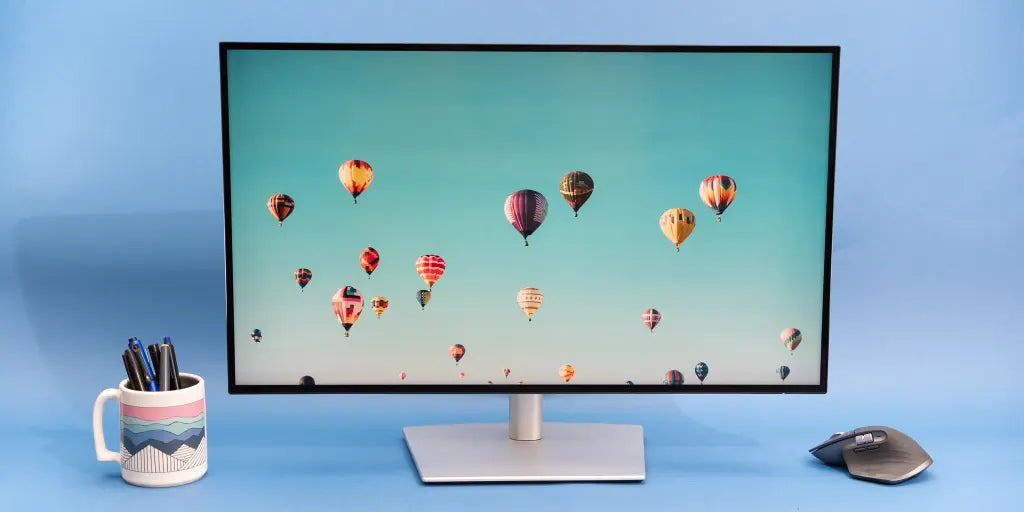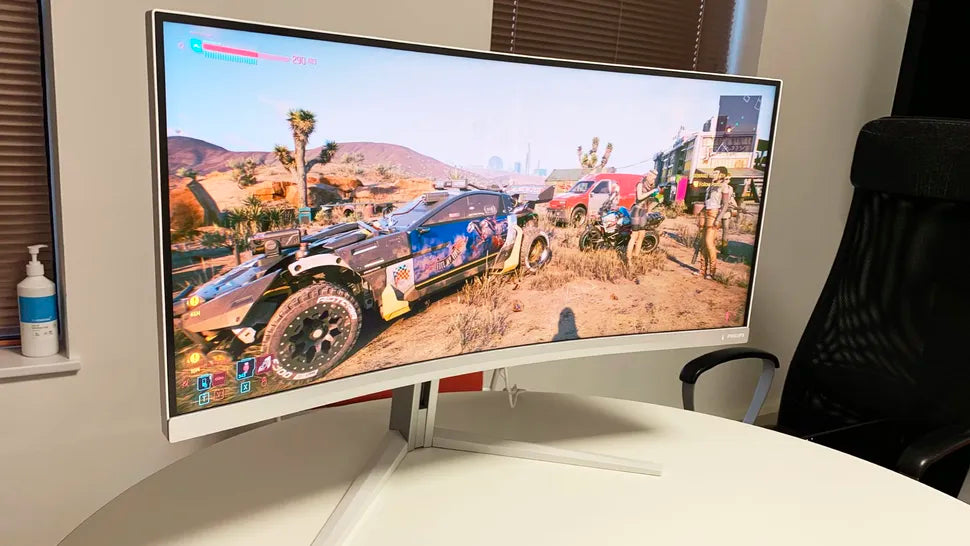IPS displays usually reach 400-500 nits brightness with a 1000:1 contrast ratio, while Mini-LEDs hit 1000+ nits and boast 1,000,000:1 contrast via local dimming, using less energy by focusing light where needed.
Brightness
IPS panels generally deliver 400–500 nits peak brightness in typical indoor settings, sufficient for most office work or streaming. Mini-LED displays, by contrast, achieve 1000–1500 nits sustained brightness, with high-end models like Apple’s Pro Display XDR reaching up to 2000 nits for HDR content. This difference matters: sunlight washes out IPS screens at 400 nits, but Mini-LEDs stay readable at 1500 nits. For HDR, VESA’s DisplayHDR 1000 certification requires 1000 nits peak—most IPS panels max out at DisplayHDR 400 (400 nits), while Mini-LEDs easily hit DisplayHDR 1400 or higher.
IPS uses global backlighting: Mini-LED splits the backlight into 200–1000+ zones (e.g., Samsung’s Neo QLED has 576 zones), dimming dark areas while boosting bright ones. In a dark room watching Dune, an IPS screen might show stars at 50 nits against a 200-nit sky, but a Mini-LED with 1000 zones hits 30 nits for stars and 1800 nits for the sunlit desert, making details pop.
Real-world tests show Mini-LEDs maintain 90% of peak brightness at 60° viewing angles, while IPS drops to 75% due to IPS glow (light leaking from edges). Power-wise, a 27” 4K IPS draws ~30W at max brightness; a Mini-LED of the same size uses ~45W—but only when pushing 1500 nits. At typical 300-nit office use, both sip ~15W, narrowing the gap.
|
Feature |
IPS Display |
Mini-LED Display |
|---|---|---|
|
Max Sustained Brightness |
400–500 nits |
1000–2000 nits |
|
HDR Certification |
DisplayHDR 400–600 |
DisplayHDR 1000–1400+ |
|
Backlight Zones |
N/A (global) |
200–1000+ |
|
Viewing Angle Brightness Loss |
~25% at 60° |
~10% at 60° |
|
Power at 300 Nits |
~15W |
~16W |
Contrast
IPS displays offer a static contrast ratio of roughly 1000:1, with black levels around 0.5 nits. Mini-LED screens, using local dimming with 200–1000+ backlight zones, achieve 1,000,000:1 or higher contrast, plunging black levels to 0.0001–0.001 nits.
IPS relies on global backlighting: every pixel’s brightness is tied to a single, uniformly lit layer. This causes unavoidable light leakage. DisplayMate lab tests confirm IPS black levels stay between 0.4–0.6 nits: alley shadows look gray instead of inky, and bat-signal glows lose sharpness.
A 27” Samsung Neo QLED with 576 zones can dim specific areas independently. But zone count matters: under 300 zones, blooming occurs. A 4K Mini-LED with 500 zones (like LG’s UltraFine 27MD5KL-B) minimizes this: Cyberpunk 2077’s neon signs glow without lighting up adjacent dark streets.
Displaying a full-black screen, a 27” Mini-LED draws ~5W (zones off where possible), while IPS uses ~15W (backlight stays on globally). Over 8 hours of dark-mode work, that’s ~80Wh saved—extending laptop battery by 1–1.5 hours.
Entry-level Mini-LEDs (under 1000+) with 1000+ zones reach DisplayHDR 1400 standards: blacks dip to 0.0001 nits, and highlights hit 1500 nits.

Efficiency
IPS panels draw around 30W at 4K max brightness, while Mini-LEDs use 45W—but at typical 300-nit office use, both sip ~15W. Mini-LED’s zoned backlight cuts power in dark scenes: a full-black screen uses 5W vs. IPS’s 15W, saving battery for laptops.
IPS relies on global backlighting: even black pixels keep the entire panel lit—DisplayMate tests show IPS leaks 10–15% more power in dark scenes than Mini-LEDs. Mini-LED splits the backlight into 200–1000+ zones. A 27” Samsung Neo QLED with 576 zones uses ~5W for full black, compared to IPS’s 15W—67% less power for the same output.
A 14-inch IPS laptop with a 2.8GHz Core i7 and 58Wh battery lasts 9 hours playing 1080p video. A comparable Mini-LED laptop (with 500 zones) uses ~22W during playback but lasts 7.5 hours, but lower the brightness to 200 nits (common indoors): the Mini-LED drops to 16W, matching the IPS’s 18W.
Long-term savings add up. Over 365 days of 4 hours daily dark-mode work:
-
IPS laptop: 15W × 4h × 365 = 21.9kWh
-
Mini-LED laptop: 5W × 4h × 365 = 7.3kWh
That’s 14.6kWh saved—enough to power a 60W LED bulb for 243 hours or cut your bill by 2/month (at $0.10/kWh).
Power use also depends on brightness. At 1000 nits (for HDR), Mini-LEDs use ~60W, while IPS maxes at 50W—but IPS can’t hit 1000 nits, so it’s irrelevant for HDR. For SDR at 200 nits, both use ~12W.
Energy Star backs this: Mini-LEDs with 1000+ zones get “High Efficiency” ratings for zoned backlighting, while IPS gets “Standard” for global lighting. Even entry-level Mini-LEDs (under $500) with 300 zones use ~7W for full black—better than IPS’s 15W.
Screen Edge Uniformity
IPS displays often show 10–15% higher brightness at screen edges versus the center due to global backlighting, while Mini-LEDs with 500+ zones keep edge brightness deviation under 5%.
IPS relies on global backlighting: a single light strip powers the entire display, so edges naturally collect more light—DisplayMate lab tests measure IPS edge brightness at 110–115% of center brightness on average. A flagship Dell UltraSharp IPS (27”, 4K) scores B+ in DisplayMate’s Edge Uniformity benchmark, with edge brightness 12% higher than center.
Mini-LED improves this with zoned backlights, though performance scales with zone count:
-
Budget Mini-LEDs (under $500): 300 zones, edge brightness deviates 6–8% from center, DisplayMate score B.
-
Mid-range Mini-LEDs (1000): 500–700 zones, edge brightness within 3–5% of center, score A-.
-
High-end Mini-LEDs (over $1000): 1000+ zones, edge brightness matches center to 2–3%, score A.
For example, Samsung’s Neo QLED (27”, 576 zones) hits 96–98% center brightness at edges. LG’s UltraFine 27MD5KL-B (500 zones) stays within 4% deviation.
Power efficiency ties in too: Mini-LED’s edge zones dim to 0.01 nits (full black), while IPS edges linger at 0.3 nits—30x more light leakage.
VESA’s DisplayHDR 1400 standard mandates edge uniformity within 5%, which most Mini-LEDs meet but few IPS panels achieve.
Portable Battery Drain
IPS laptops with 58Wh batteries last ~9 hours playing 1080p video, while Mini-LED models (with 70Wh batteries) last ~7.5 hours—dim to 200 nits (common indoors), both hit ~8 hours.
IPS relies on global backlighting: even in dark scenes, the entire panel stays lit—DisplayMate tests show an IPS screen uses ~15W at 300 nits (typical office brightness), rising to 15W at full white. Mini-LED uses zoned backlighting: at 300 nits, it also uses ~15W, but in full black screens, it drops to 5W—67% less power than IPS’s 15W.
This matters for tasks like reading e-books or working in dark mode: a 14-inch IPS laptop (Dell XPS 13, 58Wh) lasts 9 hours on battery; a comparable Mini-LED laptop (Razer Blade 14, 70Wh) lasts 7.5 hours—but lower the brightness to 200 nits, the Razer’s Mini-LED cuts power to 16W (vs. Dell’s 18W), extending its runtime to 8.5 hours.
Outdoor use flips the script: Mini-LED’s ability to hit 1000 nits (vs. IPS’s 500 nits max) means you don’t need to crank brightness to see the screen—so while a Mini-LED uses ~60W at 1000 nits, an IPS would max out at 50W but still look washed out.
Long-term savings add up: over 365 days of 4 hours daily dark-mode work:
-
IPS laptop: 15W × 4h × 365 = 21.9kWh
-
Mini-LED laptop: 5W × 4h × 365 = 7.3kWh
That’s 14.6kWh saved—enough to power a 60W LED bulb for 243 hours or cut your annual electricity bill by 2 (at $0.10/kWh).
Battery capacity also plays a role: Mini-LED laptops often pack larger batteries (e.g., 70Wh vs. IPS’s 58Wh) to offset higher peak power use. A 16-inch MacBook Pro with Mini-LED (100Wh battery) lasts 10 hours at 300 nits—same as the IPS MacBook Air (89Wh).
Read more

Though AHVA, PLS, and e-IPS all leverage IPS tech for wide ~178° viewing angles, they differ subtly: AU Optronics’ AHVA often hits higher contrast (~1000:1) for richer blacks; Samsung’s PLS typical...

For your IPS display, gently clean fingerprints with a microfiber cloth lightly moistened in a 50/50 distilled water-white vinegar mix (skip alcohol!), adjust brightness/contrast to 70-80% to cut e...



Leave a comment
This site is protected by hCaptcha and the hCaptcha Privacy Policy and Terms of Service apply.